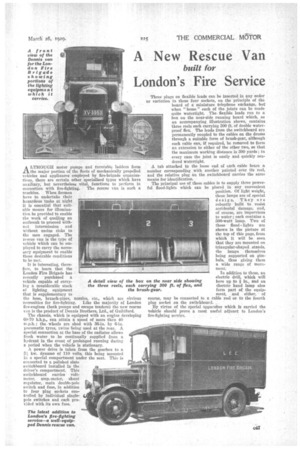A New Rescue Van
Page 77

If you've noticed an error in this article please click here to report it so we can fix it.
built for
London's Fire Service
ALTHOUGH motor pumps and turntable ladders form the major portion of the fleets of mechanically propelled vehicles and appliances employed by fire-brigade organizations, there are certain other specialized types which have auxiliary, but nevertheless vital, functions to perform in
connection with Ere-fighting. The rescue van is such a machine. When firemen have to undertake their hazardous tasks at night it is essential that suitable means for illumination be provided to enable the work of quelling an outbreak to proceed without intermission and without undue risks to the men engaged. The rescue van is the type of vehicle which can be employed to carry the necessary equipment to enable these desirable conditions to be met.
It is interesting, therefore, to learn that the London Fire Brigade has recently purchased a vehicle capable of carrying a considerable stock of lighting equipment that is supplementary to the hose, branch-pipes, nozzles, etc., which are obvious necessities for fire-fighting. Like the majority of London fire-engines (both pumps and escape tenders) the new rescue van is the product of Dennis Brothers, Ltd., of Guildford.
The chassis, 'which is equipped with an engine developing 60-70 b.h.p., can attain a speed of more than 40
; the wheels are shod with 36-in. by 6-in. pneumatic tyres, twins being used at the rear. A special connection at the base of the radiator allows fresh water to be continually supplied from a hydrant in the event of prolonged running during a period when the vehicle is stationary. A detail view of the three reels,
Three plugs on flexible leads can be inserted in any order or variation in these four sockets, on the principle of the board of a miniature telephone exchange, but when " home " each of the joints can be made quite watertight. The, flexible leads run to a box on the near-side running board which, as an accompanying illustration shows, contains three reels each carrying 300 ft. of double -waterproof flex. The leads from the switchboard are permanently coupled to the cables on the drunks through a suitable form of brush-gear, although each cable can, if required, be removed to fount an extension to either of the other two, go that the maximum working distance is 300 yards ; in every case the joint is easily and quickly ren
dered watertight. '
A tab attached to the loose end of each cable bears a number corresponding with another painted over its reel, and the relative plug on the switchboard carries the same means for identification. The principal use of these cables is to supply three powerful flood-lights which can be placed in any convenient
position. Of light weight, these lamps are of special design. They are robustly built to resist accidental damage, and, of course, are impervious to water ; each contains a -1/0-watt lamp. Two of these flood-lights are shown in the picture at the top of this page, from which it will be seen that they are mounted on triangular-shaped stands, the lamps themselves being supported on gimbals, thus giving them a wide range of movement.
In addition to these, an electric drill, which will bore up to 4 in., and an electric hand lamp also form part of the equipment, and either, of course, may be connected to a cable reel or to the fourth plug socket on the switchboard.
By virtue of the special apparatus which is carried the Vehicle should prove a most useful adjunct to London's fire-fighting service. the box on the near aide showing each carrying 300 ft. of flex, and the brush-gear.




























































































































